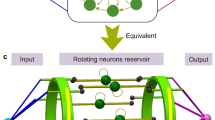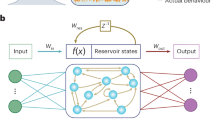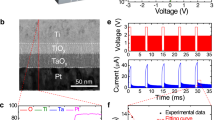Abstract
Reservoir computing offers a powerful neuromorphic computing architecture for spatiotemporal signal processing. To boost the power efficiency of the hardware implementations of reservoir computing systems, analogue devices and components—including spintronic oscillators, photonic modules, nanowire networks and memristors—have been used to partially replace the elements of fully digital systems. However, the development of fully analogue reservoir computing systems remains limited. Here we report a fully analogue reservoir computing system that uses dynamic memristors for the reservoir layer and non-volatile memristors for the readout layer. The system can efficiently process spatiotemporal signals in real time with three orders of magnitude lower power consumption than digital hardware. We illustrate the capabilities of the system using temporal arrhythmia detection and spatiotemporal dynamic gesture recognition tasks, achieving accuracies of 96.6% and 97.9%, respectively. Our memristor-based fully analogue reservoir computing system could be of use in edge computing applications that require extremely low power and hardware cost.
This is a preview of subscription content, access via your institution
Access options
Access Nature and 54 other Nature Portfolio journals
Get Nature+, our best-value online-access subscription
$32.99 / 30 days
cancel any time
Subscribe to this journal
Receive 12 digital issues and online access to articles
$119.00 per year
only $9.92 per issue
Buy this article
- Purchase on SpringerLink
- Instant access to full article PDF
Prices may be subject to local taxes which are calculated during checkout





Similar content being viewed by others
Data availability
Data that support the findings of this study are available from the corresponding authors upon reasonable request. Source data are provided with this paper.
Code availability
The code that supports the DM-RC system simulations in this study is available via GitHub at https://github.com/Tsinghua-LEMON-Lab/Reservoir-computing. Other codes that support the findings of this study are available from the corresponding authors upon reasonable request.
References
Zidan, M. A., Strachan, J. P. & Lu, W. D. The future of electronics based on memristive systems. Nat. Electron. 1, 22–29 (2018).
Zhang, W. et al. Neuro-inspired computing chips. Nat. Electron. 3, 371–382 (2020).
Chua, L. Memristor—the missing circuit element. IEEE Trans. Circuit Theory 18, 507–519 (1971).
Strukov, D. B., Snider, G. S., Stewart, D. R. & Williams, R. S. The missing memristor found. Nature 453, 80–83 (2008).
Cai, F. et al. Power-efficient combinatorial optimization using intrinsic noise in memristor Hopfield neural networks. Nat. Electron. 3, 409–418 (2020).
Li, X. et al. Power-efficient neural network with artificial dendrites. Nat. Nanotechnol. 15, 776–782 (2020).
Kumar, S., Williams, R. S. & Wang, Z. Third-order nanocircuit elements for neuromorphic engineering. Nature 585, 518–523 (2020).
Yao, P. et al. Face classification using electronic synapses. Nat. Commun. 8, 15199 (2017).
Yao, P. et al. Fully hardware-implemented memristor convolutional neural network. Nature 577, 641–646 (2020).
Dalgaty, T. et al. In situ learning using intrinsic memristor variability via Markov chain Monte Carlo sampling. Nat. Electron. 4, 151–161 (2021).
Cai, F. et al. A fully integrated reprogrammable memristor–CMOS system for efficient multiply–accumulate operations. Nat. Electron. 2, 290–299 (2019).
Hochreiter, S. & Schmidhuber, J. Long short-term memory. Neural Comput. 9, 1735–1780 (1997).
Hopfield, J. J. Neural networks and physical systems with emergent collective computational abilities. Proc. Natl Acad. Sci. USA 79, 2554–2558 (1982).
Salmela, L. et al. Predicting ultrafast nonlinear dynamics in fibre optics with a recurrent neural network. Nat. Mach. Intell. 3, 344–354 (2021).
Wright, L. G. et al. Deep physical neural networks trained with backpropagation. Nature 601, 549–555 (2022).
Appeltant, L. et al. Information processing using a single dynamical node as complex system. Nat. Commun. 2, 468 (2011).
Shastri, B. J. et al. Photonics for artificial intelligence and neuromorphic computing. Nat. Photon. 15, 102–114 (2021).
Jaeger, H. The ‘echo state’ approach to analysing and training recurrent neural networks—with an erratum note. Bonn., Ger.: Ger. Natl Res. Cent. Inf. Technol. GMD Tech. Rep. 148, 13 (2001).
Maass, W., Natschläger, T. & Markram, H. Real-time computing without stable states: a new framework for neural computation based on perturbations. Neural Comput. 14, 2531–2560 (2002).
Gauthier, D. J., Bollt, E., Griffith, A. & Barbosa, W. A. S. Next generation reservoir computing. Nat. Commun. 12, 5564 (2021).
Alomar, M. L. et al. Digital implementation of a single dynamical node reservoir computer. IEEE Trans. Circuits Syst., II, Exp. Briefs 62, 977–981 (2015).
Wang, Q. et al. Energy efficient parallel neuromorphic architectures with approximate arithmetic on FPGA. Neurocomputing 221, 146–158 (2017).
Kleyko, D., Frady, E. P., Kheffache, M. & Osipov, E. Integer echo state networks: efficient reservoir computing for digital hardware. IEEE Trans. Neural Netw. Learn. Syst. 33, 1688–1701 (2020).
Torrejon, J. et al. Neuromorphic computing with nanoscale spintronic oscillators. Nature 547, 428–431 (2017).
Riou, M. et al. Neuromorphic computing through time-multiplexing with a spin-torque nano-oscillator. In 2017 IEEE International Electron Devices Meeting (IEDM) 36.3.1–36.3.4 (IEEE, 2017).
Nakane, R., Tanaka, G. & Hirose, A. Reservoir computing with spin waves excited in a garnet film. IEEE Access 6, 4462–4469 (2018).
Martinenghi, R. et al. Photonic nonlinear transient computing with multiple-delay wavelength dynamics. Phys. Rev. Lett. 108, 244101 (2012).
Vandoorne, K. et al. Experimental demonstration of reservoir computing on a silicon photonics chip. Nat. Commun. 5, 3541 (2014).
Antonik, P., Marsal, N., Brunner, D. & Rontani, D. Human action recognition with a large-scale brain-inspired photonic computer. Nat. Mach. Intell. 1, 530–537 (2019).
Hochstetter, J. et al. Avalanches and edge-of-chaos learning in neuromorphic nanowire networks. Nat. Commun. 12, 4008 (2021).
Fu, K. et al. Reservoir computing with neuromemristive nanowire networks. In 2020 International Joint Conference on Neural Networks (IJCNN) 1–8 (IEEE, 2020).
Milano, G. et al. In materia reservoir computing with a fully memristive architecture based on self-organizing nanowire networks. Nat. Mater. 21, 195–202 (2022).
Zhong, Y. et al. Dynamic memristor-based reservoir computing for high-efficiency temporal signal processing. Nat. Commun. 12, 408 (2021).
Moon, J. et al. Temporal data classification and forecasting using a memristor-based reservoir computing system. Nat. Electron. 2, 480–487 (2019).
Yu, J. et al. Energy efficient and robust reservoir computing system using ultrathin (3.5 nm) ferroelectric tunneling junctions for temporal data learning. In 2021 Symposium on VLSI Technology 1–2 (IEEE, 2021).
Tanaka, G. et al. Recent advances in physical reservoir computing: a review. Neural Netw. 115, 100–123 (2019).
Gao, B. et al. Oxide-based analog synapse: physical modeling, experimental characterization, and optimization. In 2016 IEEE International Electron Devices Meeting (IEDM) 7.3.1–7.3.4 (IEEE, 2016).
Li, C. et al. Analogue signal and image processing with large memristor crossbars. Nat. Electron. 1, 52–59 (2017).
Li, C. et al. Efficient and self-adaptive in-situ learning in multilayer memristor neural networks. Nat. Commun. 9, 2385 (2018).
Moody, G. B. & Mark, R. G. The impact of the MIT-BIH arrhythmia database. IEEE Eng. Med. Biol. Mag. 20, 45–50 (2001).
Lukosevicius, M. & Jaeger, H. Survey: reservoir computing approaches to recurrent neural network training. Comput. Sci. Rev. 3, 127–149 (2009).
Wan, W. et al. 33.1 A 74 TMACS/W CMOS-RRAM neurosynaptic core with dynamically reconfigurable dataflow and in-situ transposable weights for probabilistic graphical models. In 2020 IEEE International Solid-State Circuits Conference—(ISSCC) 498–500 (IEEE, 2020).
Brunner, D., Soriano, M. C., Mirasso, C. R. & Fischer, I. Parallel photonic information processing at gigabyte per second data rates using transient states. Nat. Commun. 4, 1364 (2013).
Liang, X. et al. Rotating neurons for all-analog implementation of cyclic reservoir computing. Nat. Commun. 13, 1549 (2022).
Acknowledgements
This work was supported in part by China Key Research and Development Program (2021ZD0201205), National Natural Science Foundation of China (91964104, 61974081, 62025111, 92064001 and 62104126) and the XPLORER Prize.
Author information
Authors and Affiliations
Contributions
Y.Z. and J.T. conceived and designed the experiments. Xinyi Li contributed to device preparation and material analysis. Y.Z. performed the experiments and data analysis. Y.Z. and J.T. wrote the paper. All the authors discussed the results and commented on the manuscript. J.T., H.W. and H.Q. supervised the project.
Corresponding authors
Ethics declarations
Competing interests
The authors declare no competing interests.
Peer review
Peer review information
Nature Electronics thanks Xiaobing Yan and the other, anonymous, reviewer(s) for their contribution to the peer review of this work.
Additional information
Publisher’s note Springer Nature remains neutral with regard to jurisdictional claims in published maps and institutional affiliations.
Supplementary Information
Supplementary Information
Supplementary Figs. 1–9 and Tables 1 and 2.
41928_2022_838_MOESM2_ESM.mp4
Real-time demonstration of the DM-RC system.
Source data
Source Data Fig. 2
Statistical source data.
Source Data Fig. 3
Statistical source data.
Source Data Fig. 4
Statistical source data.
Source Data Fig. 5
Statistical source data.
Rights and permissions
Springer Nature or its licensor holds exclusive rights to this article under a publishing agreement with the author(s) or other rightsholder(s); author self-archiving of the accepted manuscript version of this article is solely governed by the terms of such publishing agreement and applicable law.
About this article
Cite this article
Zhong, Y., Tang, J., Li, X. et al. A memristor-based analogue reservoir computing system for real-time and power-efficient signal processing. Nat Electron 5, 672–681 (2022). https://doi.org/10.1038/s41928-022-00838-3
Received:
Accepted:
Published:
Issue date:
DOI: https://doi.org/10.1038/s41928-022-00838-3
This article is cited by
-
Reconstructive spectrometers: hardware miniaturization and computational reconstruction
eLight (2025)
-
Molecular crystal memristors
Nature Nanotechnology (2025)
-
Transforming memristor noises into computational innovations
Communications Materials (2025)
-
Skin-conformal electronics for intelligent gesture recognition
Nature Reviews Electrical Engineering (2025)
-
Optoelectronic polymer memristors with dynamic control for power-efficient in-sensor edge computing
Light: Science & Applications (2025)



